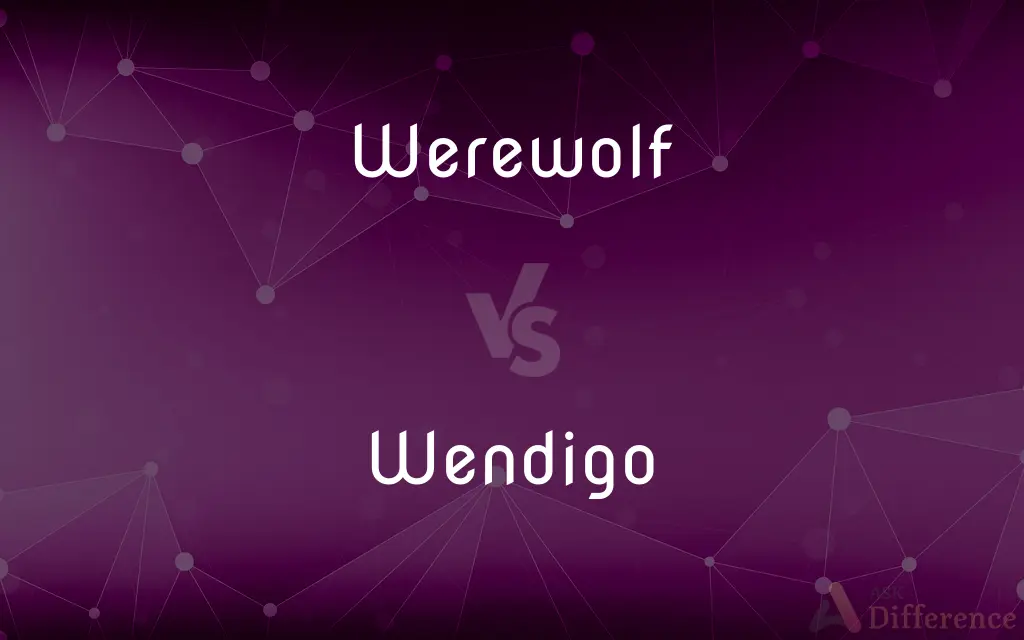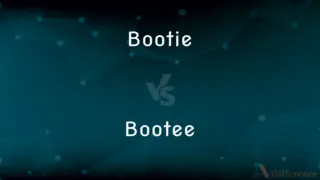Werewolf vs. Wendigo — What's the Difference?
By Tayyaba Rehman & Urooj Arif — Updated on April 5, 2024
Werewolves are mythical creatures that transform from humans into wolves, whereas Wendigos are depicted as malevolent, cannibalistic beings from Native American folklore.

Difference Between Werewolf and Wendigo
Table of Contents
ADVERTISEMENT
Key Differences
Werewolves are part of European folklore, known for their transformation from human to wolf during a full moon, embodying the struggle between human nature and wild instincts. On the other hand, Wendigos originate from the folklore of indigenous peoples of North America, particularly around the Great Lakes, and are associated with insatiable greed and cannibalism, often seen as a warning against excess.
The myth of the werewolf often involves a curse or affliction, causing involuntary transformation and loss of human consciousness, leading to acts of savagery. Whereas, the Wendigo myth suggests transformation as a consequence of extreme conditions, such as famine or greed, resulting in the loss of humanity and the assumption of a monstrous form that is forever hungry.
Werewolves are typically depicted in myths and popular culture as having physical strength, speed, and enhanced senses, making them formidable creatures. In contrast, Wendigos are often described as gaunt, with desiccated skin and an emaciated appearance, reflecting their eternal hunger and association with famine and starvation.
The lore around werewolves includes various methods of becoming one, such as being bitten or scratched by another werewolf, or through a curse. Wendigos, however, are said to arise from humans resorting to cannibalism or being consumed by greed, embodying a spiritual and physical corruption.
Werewolves and Wendigos serve as symbols within their respective cultures. Werewolves often represent the internal battle between man’s civilized nature and wild, animalistic urges. Wendigos, on the other hand, symbolize the dangers of overconsumption and greed, warning against the consequences of losing one's humanity.
ADVERTISEMENT
Comparison Chart
Origin
European folklore.
Native American folklore, particularly from the Great Lakes region.
Transformation
From human to wolf, often during a full moon.
From human to a monstrous entity due to cannibalism or extreme greed.
Characteristics
Physically powerful, with enhanced senses and speed.
Emaciated appearance, symbolizing insatiable hunger and cold.
Cause
Curse, bite, or scratch from another werewolf.
Result of cannibalism or extreme greed and conditions.
Symbolism
Struggle between human nature and animalistic instincts.
Warnings against greed, excess, and loss of humanity.
Compare with Definitions
Werewolf
Subject of many myths and legends, embodying themes of transformation and duality.
The werewolf legend has fascinated people for centuries, embodying the fear of the wilderness.
Wendigo
A cautionary figure, symbolizing the consequences of excess and moral decay.
The legend of the Wendigo served as a grim reminder against the perils of greed.
Werewolf
A mythological or folkloric human with the ability to shapeshift into a wolf.
The legend spoke of a werewolf that roamed the forests under the full moon.
Wendigo
Often depicted as a gaunt, skeletal figure, embodying famine and extreme conditions.
The Wendigo was said to wander the snowy wastes, forever hungry, a ghost of the forest.
Werewolf
A creature often depicted in horror stories as a symbol of conflict between the human and beastly natures.
In stories, the werewolf's curse tormented him, caught between two worlds.
Wendigo
A representation of insatiable hunger and the extremes of human depravity.
In stories, the Wendigo grew ever more ravenous, no matter how much it consumed.
Werewolf
A being cursed to transform into a wolf-like creature, typically during a full moon.
He feared the night of the full moon, for that was when he became a werewolf.
Wendigo
A mythical being that arises from the darkest aspects of human behavior.
The Wendigo, born from cannibalism, represented the ultimate taboo and the loss of one’s humanity.
Werewolf
A character in folklore that is both feared and pitied for its dual nature.
The werewolf, a tragic figure, sought a cure for his curse to regain his humanity.
Wendigo
A creature from Native American folklore, associated with cannibalism, greed, and the winter.
The tale of the Wendigo warned of the dangers of isolation and despair in the harsh winter.
Werewolf
In folklore, a werewolf (Old English: werwulf, "man-wolf"), or occasionally lycanthrope (Greek: λυκάνθρωπος lukánthrōpos, "wolf-human"), is a human with the ability to shapeshift into a wolf (or, especially in modern film, a therianthropic hybrid wolflike creature), either purposely or after being placed under a curse or affliction (often a bite or scratch from another werewolf) with the transformations occurring on the night of a full moon. Early sources for belief in this ability or affliction, called lycanthropy , are Petronius (27–66) and Gervase of Tilbury (1150–1228).
Wendigo
Wendigo () is a mythological creature or evil spirit which originates from the folklore of First Nations based in and around the East Coast forests of Canada, the Great Plains region of the United States, and the Great Lakes region of the United States and Canada, grouped in modern ethnology as speakers of Algonquian-family languages. The wendigo is often said to be a malevolent spirit, sometimes depicted as a creature with human-like characteristics, which possesses human beings.
Werewolf
A person believed to have been transformed into a wolf or to be capable of assuming the form of a wolf.
Wendigo
(mythological creature) A malevolent and violent cannibal spirit found in Anishinaabe, Ojibwe, and Cree mythology, which is said to inhabit the body of a living person and possess him or her to commit murder.
Werewolf
(mythology) A person who is transformed or can transform into a wolf or a wolflike human, often said to transform during a full moon. Category:en:Horror
Wendigo
Synonym of splake
Werewolf
A person transformed into a wolf in form and appetite, either temporarily or permanently, whether by supernatural influences, by witchcraft, or voluntarily; a lycanthrope. Belief in werewolves, formerly general, is not now extinct.
The werwolf went about his prey.
The brutes that wear our form and face,The werewolves of the human race.
Werewolf
A monster able to change appearance from human to wolf
Common Curiosities
Can a Wendigo ever be satisfied or revert back to human form?
Folklore suggests that Wendigos are forever hungry and cannot revert back, as they symbolize insatiable greed and the loss of humanity.
Is there any known weakness for werewolves and Wendigos?
Werewolves are traditionally vulnerable to silver and certain mystical methods. Wendigos, being more spiritual, are said to be vulnerable to fire and certain rituals.
What triggers a werewolf transformation?
A werewolf typically transforms due to a curse or the influence of a full moon, often after being bitten or scratched by another werewolf.
How can someone become a Wendigo?
According to folklore, a person becomes a Wendigo as a result of cannibalism or through extreme greed and moral corruption.
Are werewolves and Wendigos considered evil?
Werewolves are often portrayed as tragic figures battling their nature, while Wendigos are depicted as malevolent entities symbolizing greed and excess.
Are there any protective measures against werewolves and Wendigos?
Folklore suggests various protective measures, including charms, rituals, and avoidance of certain behaviors that could lead to transformation.
How has the depiction of werewolves and Wendigos evolved in popular culture?
Their depictions have evolved from purely malevolent creatures to more nuanced characters that can sometimes elicit sympathy or serve as antiheroes.
How do werewolves and Wendigos differ in their origins?
Werewolves originate from European folklore, while Wendigos come from the folklore of Native American tribes, especially around the Great Lakes.
Can Wendigos be cured in folklore?
Wendigo folklore sometimes includes stories of curing the afflicted, often through intense spiritual and physical purification processes, but these are rare and difficult.
Do werewolves have any control over their actions?
In many stories, werewolves lack control over their actions when transformed, highlighting the tragic nature of their condition.
What role do werewolves and Wendigos play in their respective cultures?
Both serve as cautionary tales; werewolves about the inner beast within humans, and Wendigos about the dangers of greed and moral decay.
What is the significance of the full moon in werewolf lore?
The full moon is often depicted as a trigger for the werewolf's transformation, symbolizing the unleashing of primal instincts and loss of control.
Share Your Discovery

Previous Comparison
Bootie vs. Bootee
Next Comparison
Concoction vs. MixtureAuthor Spotlight
Written by
Tayyaba RehmanTayyaba Rehman is a distinguished writer, currently serving as a primary contributor to askdifference.com. As a researcher in semantics and etymology, Tayyaba's passion for the complexity of languages and their distinctions has found a perfect home on the platform. Tayyaba delves into the intricacies of language, distinguishing between commonly confused words and phrases, thereby providing clarity for readers worldwide.
Co-written by
Urooj ArifUrooj is a skilled content writer at Ask Difference, known for her exceptional ability to simplify complex topics into engaging and informative content. With a passion for research and a flair for clear, concise writing, she consistently delivers articles that resonate with our diverse audience.













































